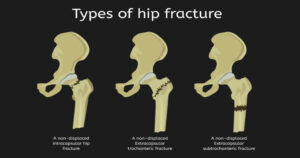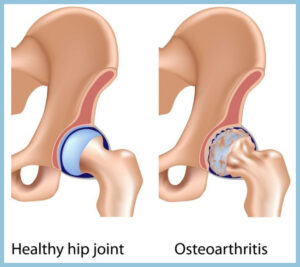- Hip Fractures,
- Hip Osteoarthritis, or
- Avascular Necrosis of the Hip (AVN).
Hip Fractures
 The hip joint consists of a socket (acetabulum) in the pelvic bone, a ball (femoral head), and ligaments that assist weight-bearing, provide balance, stability and enable a range of movements – front, back, sideways, rotation.
When a hip is fractured, there is a break in the upper fourth of the femur (thigh) bone. It can be a fragility fracture in elders or an accident fracture in youngsters. Furthermore, conditions such as osteoporosis or cancer weaken the bones around the hip and spine making them more susceptible to breaking. In such cases, a patient may require a hip implant or a total hip replacement or a bioplar hip replacement.
An X-ray can diagnose a hip fracture. It can also distinguish between an Intra-capsular fracture, Intertrochanteric fracture, and Subtrochanteric fracture.
The hip joint consists of a socket (acetabulum) in the pelvic bone, a ball (femoral head), and ligaments that assist weight-bearing, provide balance, stability and enable a range of movements – front, back, sideways, rotation.
When a hip is fractured, there is a break in the upper fourth of the femur (thigh) bone. It can be a fragility fracture in elders or an accident fracture in youngsters. Furthermore, conditions such as osteoporosis or cancer weaken the bones around the hip and spine making them more susceptible to breaking. In such cases, a patient may require a hip implant or a total hip replacement or a bioplar hip replacement.
An X-ray can diagnose a hip fracture. It can also distinguish between an Intra-capsular fracture, Intertrochanteric fracture, and Subtrochanteric fracture.
Hip Osteoarthritis
 Hip Osteoarthritis is a type of arthritis that causes wear and tear of the hip. In India, it is the second most common cause of hip replacement surgery after knee osteoarthritis. Here, the articular cartilage of the hip begins to wears off, exposing the underlying bone. When the bones rub on each other, the friction causes pain.
The hip replacement surgeon may order X-rays or an MRI scan to diagnose hip arthritis. Only when mild pain killers, supplements, and lifestyle modification don’t help, the ortho surgeon will recommend total hip replacement surgery. In this surgery, the surgeon replaces the damaged shell (socket) (acetabulum) and the ball (femoral head). The shell is made from medical-grade plastic or ceramic and the head from metal or ceramic.
When Is Total Hip Surgery Recommended
When you begin to see the following symptoms, it is time to consult the best orthopaedic surgeon for hip replacement. They include:-
Hip Osteoarthritis is a type of arthritis that causes wear and tear of the hip. In India, it is the second most common cause of hip replacement surgery after knee osteoarthritis. Here, the articular cartilage of the hip begins to wears off, exposing the underlying bone. When the bones rub on each other, the friction causes pain.
The hip replacement surgeon may order X-rays or an MRI scan to diagnose hip arthritis. Only when mild pain killers, supplements, and lifestyle modification don’t help, the ortho surgeon will recommend total hip replacement surgery. In this surgery, the surgeon replaces the damaged shell (socket) (acetabulum) and the ball (femoral head). The shell is made from medical-grade plastic or ceramic and the head from metal or ceramic.
When Is Total Hip Surgery Recommended
When you begin to see the following symptoms, it is time to consult the best orthopaedic surgeon for hip replacement. They include:-
- Pain in the hip, buttocks, groin, outer thigh.
- Stiffness when you initiate any movements after a period of rest.
- Hip movement becomes restricted and causes a limp.
- The ability to walk routinely reduces over time and becomes disabling.
Avascular Necrosis of the Hip (AVN)
Avascular necrosis or osteonecrosis of the hip occurs when blood supply to the bone is permanently lost. This condition eventually destroys the hip joint. It may be due to injury, old fracture or dislocation, damage to blood vessels, long-term use of steroids, and excessive alcohol abuse.
 Apart from clinical examination, the modalities used to diagnose AVN are X-ray’s, and in early stages where X-ray usually doesn’t pick up, MRI scan is helpful.
Apart from clinical examination, the modalities used to diagnose AVN are X-ray’s, and in early stages where X-ray usually doesn’t pick up, MRI scan is helpful.
Only when anti-inflammatory medications, activity changes, physical therapy, bisphosphonates, etc don’t help, total hip replacement is needed. Also, if the collapse has already occurred, then the surgeon will suggest Total Hip Replacement surgery.
When Is Total Hip Surgery Recommended
The AVN condition progresses over months to even years. Since its symptoms are not easy to recognize, it is advisable to visit an orthopaedic surgeon for a consultation.
Procedure for Total Hip Replacement
The type of surgery depends on the age and the fracture pattern. It can either be a repair of the fracture or replacement of the head of the femur or replacement of both, the socket and the head. Here, the orthopaedic surgeon removes the damaged cartilage and bone and positions new metal, plastic, or ceramic implants. It restores the alignment and function of the hip.
Postoperative Care for Total Hip Replacement
Patients are encouraged to get out of bed on the same evening of the surgery or the next day. Your surgeon will also recommend:-
- A graduated walking program initially in your home and later outdoors.
- Climbing stairs is generally advised after assessing the hip strength.
- Specific daily exercises by a physiotherapist to restore movement and strengthen your hip.

